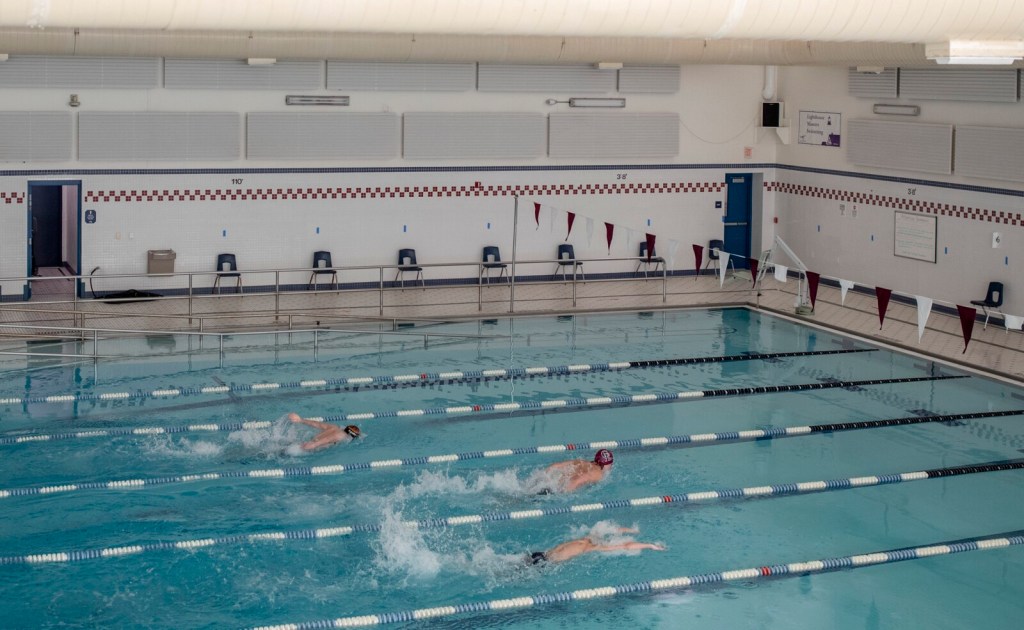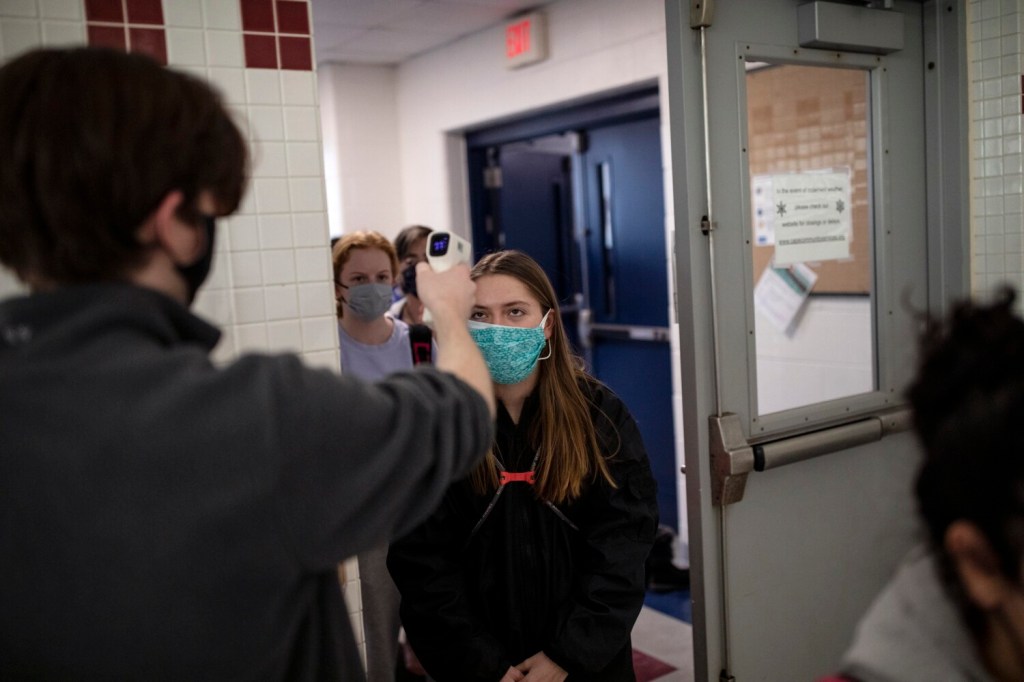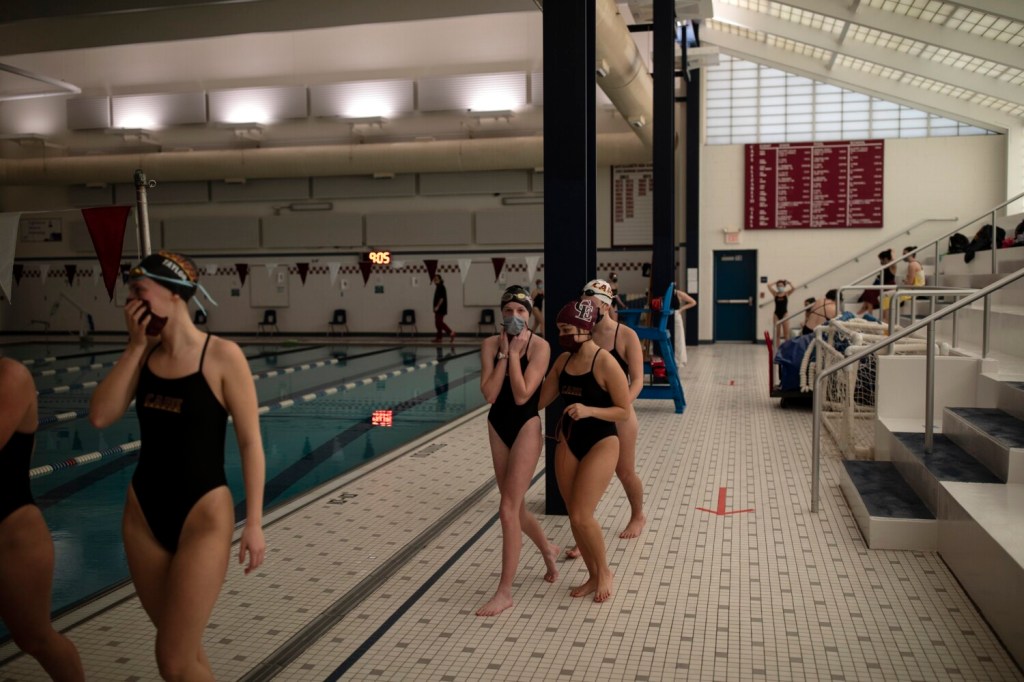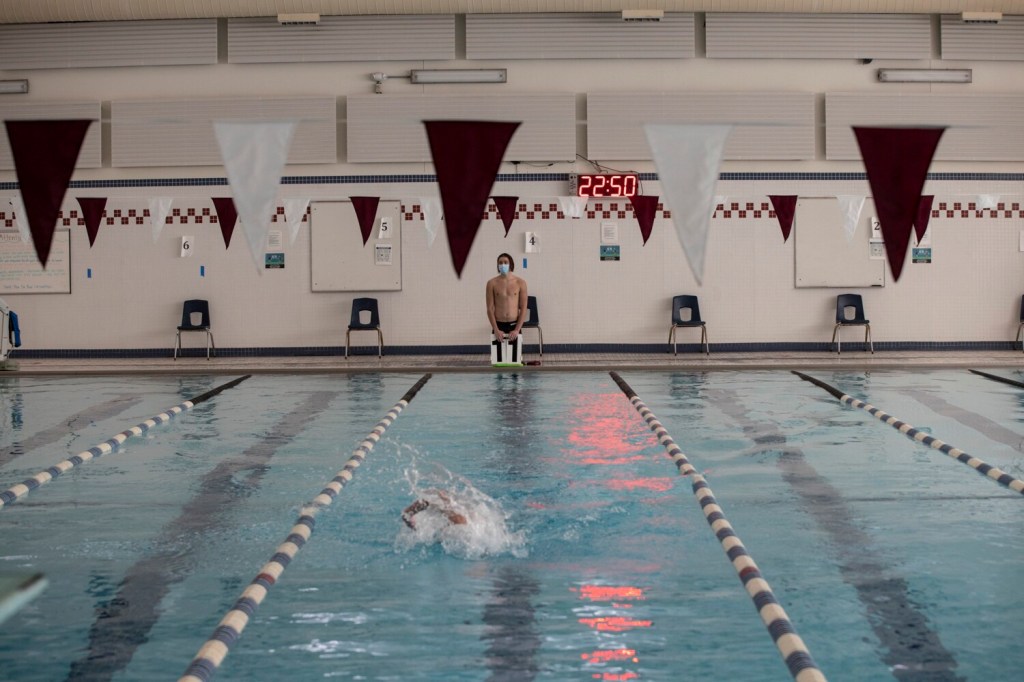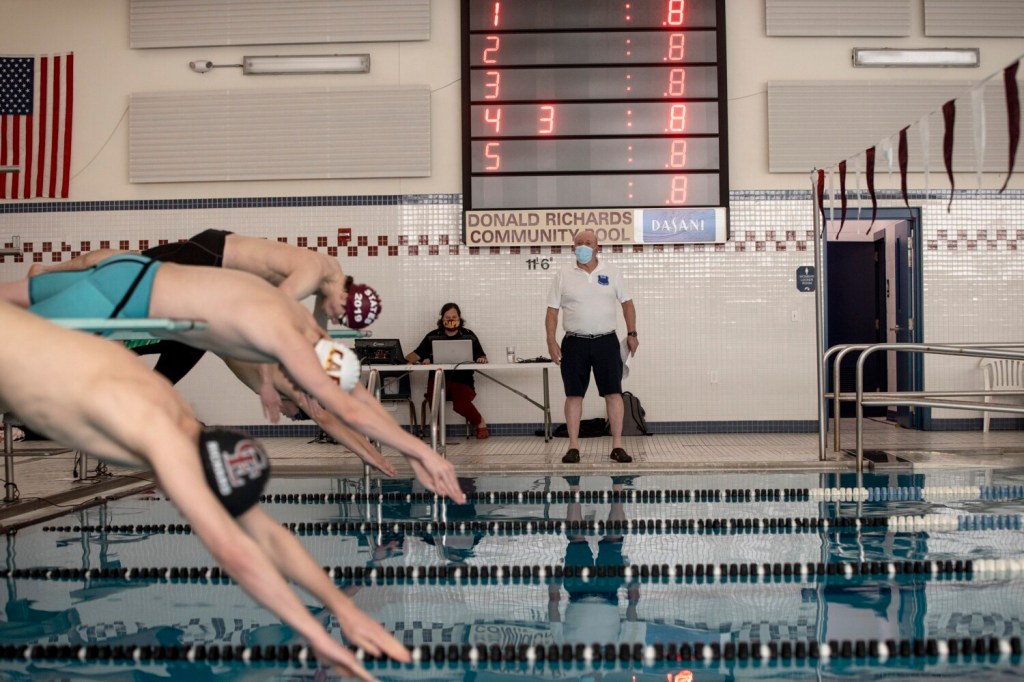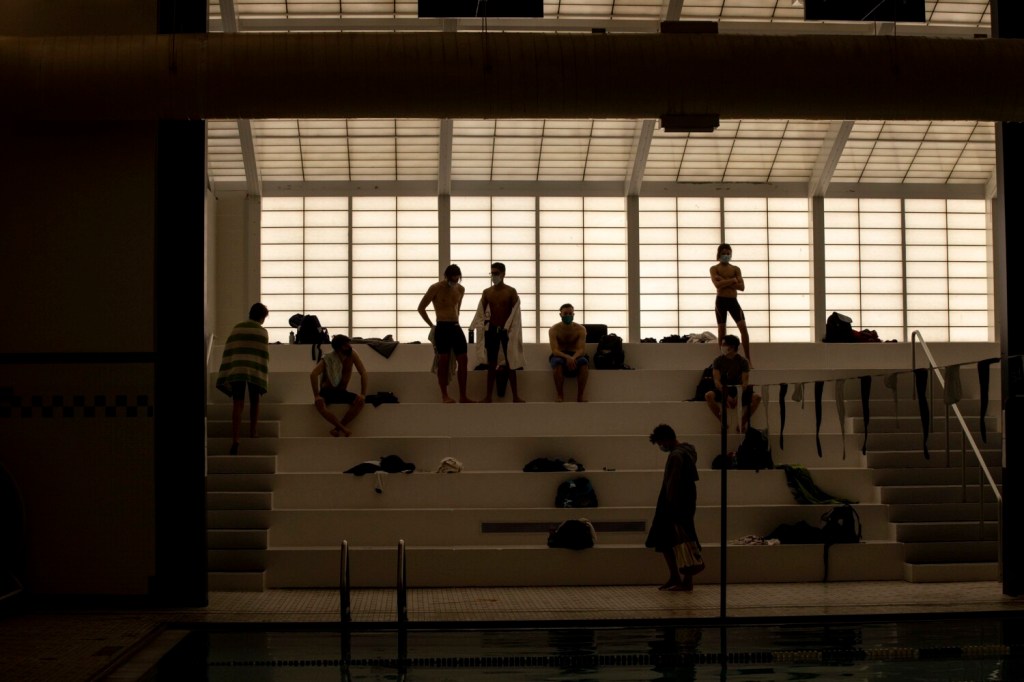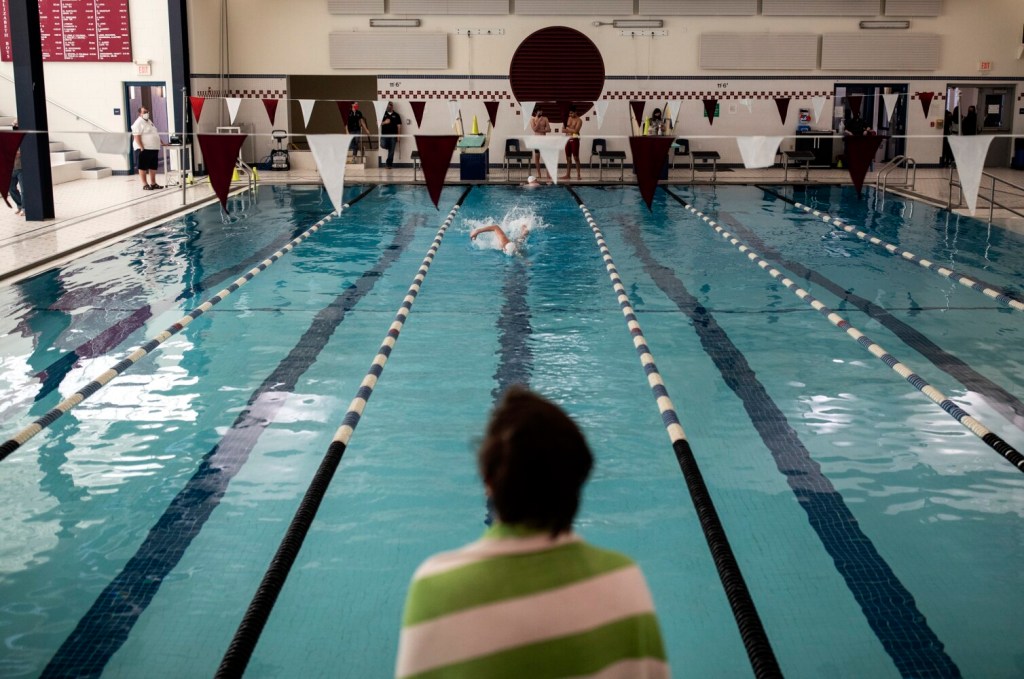Keegan McKenney pushed himself out of the pool, placed his paper face mask over his nose and mouth, and gave a slight fist bump to one of his Cape Elizabeth teammates.
That soundless touch of knuckles was the extent of the celebration for McKenney’s new school and pool record time of 51.53 seconds in the 100-yard butterfly, set Wednesday at Donald Richards Community Pool.
Welcome to Maine high school swimming during the coronavirus pandemic, where no fans are in the stands, swimming “meets” are single-team affairs, and swimmers stay in their designated, socially distanced seats until it’s their time to get into the pool. It’s a strangely subdued and almost eerily quiet atmosphere for what are being called virtual meets. Teams compete against each other in different pools, often on different days, and then submit their times to a neutral statistician who determines the winners.
For McKenney and the rest of the Cape Elizabeth swimmers – who were competing against “host” Gorham, which didn’t swim until Friday – this antiseptic and self-reliant competition is enough.
“At the end of the day, I just want to be as good as I can at swimming. And, I just like to race,” McKenney said.
McKenney’s butterfly swim was the third school record set by Cape Elizabeth’s boys’ team in two meets. On Feb. 10, juniors McKenney and Ethan Smith, freshman David Steinbrick and senior Rishi Yadav set a 200 medley relay mark in the very first race of the season. McKenney also shattered Cape’s 200 individual medley record by four seconds.
“If anything, the sense of team and teamwork and all that good stuff with your teammates, that’s definitely a lot stronger this year. Because it has to be,” said Yadav.
The Cape Elizabeth swimmers also realize they are among the fortunate teams who have basically unchanged access to pool time, with four practice times a week for every swimmer.

Cape Elizabeth junior Keegan McKenney, center, and his teammates cheer on David Steinbrick as he swims the 500-yard freestyle alone during a virtual swim meet against Gorham at Richards Community Pool on Wednesday. Because of the pandemic, swimmers are only competing against the clock this year. Then the times are compared, usually with the other teams competing on different days in their own pools. Brianna Soukup/Staff Photographer
Many high school swim teams in Maine have had to scrambling to claim any available pool time they can, including two of southern Maine’s powerhouse programs. Especially vulnerable have been teams that traditionally swim at college facilities and some YMCAs, which have closed operations to outside groups.
Cheverus High, home to the eight-time Class A boys’ champions, has been shut out of the Northern York County YMCA in Biddeford. The Stags have been able to relocate to Riverton Community Center in Portland.
Kennebunk, a robust program that won the 2020 Class A girls’ title, normally swims at the University of New England. The Rams have not been in the water this year.
Windham can’t use its long-time home at St. Joseph’s College. The Eagles have had a few in-water practices at Riverton and hope to have one virtual meet with Thornton Academy on March 6. Windham’s swimmers will keep doing dry-land training in the school gym and a variety of online activities to keep up team morale.
“I just walked through a practice in the gym, the Friday of February break at 10:30 in the morning, and they’re all here,” said Rich Drummond, Windham’s athletic director. “Yes, if you talk to them, the kids are hurting because it’s not a normal season, but the attitude of the kids has been simply outstanding and the coaches have worked their tails off to provide an opportunity.”
Thornton, Falmouth and Yarmouth are typically tenants at YMCA of Southern Maine pools: Thornton (like Cheverus) at Northern York County in Biddeford, and Falmouth and Yarmouth at the Casco Bay Y in Freeport. Each has found coveted weekend time slots at the Westbrook Community Center, which also serves as the full-time home for the Westbrook and Gorham programs.
Thornton also took the unique approach of encouraging its swimmers to purchase memberships to the YMCA, supplying the funds if necessary, so they would be able to swim on their own.

Cape Elizabeth swimmers hold masks up to their faces as they walk back from the pool during a virtual swim meet at Richards Community Pool on Wednesday. Brianna Soukup/Staff Photographer
For schools that have retained regular pool time, having only three swimmers in a lane at one time reduces the rate of practice time per individual. Scarborough High, which also uses the Richards Pool, still has its four practice times per week, but because only 18 swimmers can be in the six-lane pool at one time, just one third of the team can practice per night.
“If you can beat your time from last year in a shortened season where you practice only once every three days, then that’s a pretty darn good success story,” said Scarborough Coach Eric French, adding sophomore Ethan Schultz had already set a boys’ school record.
The method of how to hold a virtual meet varies. The basic approach is that both teams will hold their own meet, ideally within 48 hours, and the results are submitted to the “host” school on the schedule and then transferred to a statewide statistician.
Cape Elizabeth and Scarborough are two programs that have decided to hold an all-boys’ meet, then an all-girls’ meet, to align with their practice policy.
Greely, which has its own pool, is alternating boys’ and girls’ races.
“We’re allowed 50 people in the pool area, so it’s 40 swimmers, officials, timers and a couple coaches and we just squeeze under that number,” said Greely’s 30-year head coach Rob Hale.
Hale said Greely has instituted a no-cheering approach, figuring if school bands and choirs can’t perform because COVID-19 aerosol particulates’ greater trajectory, they shouldn’t have people yelling indoors. Instead, they are trying to pump up the energy with artificial noisemakers, “which is against the rules for swimming but the officials at our meet took it all in stride.”

Lifeguard Ryan Connolly does a temperature check on Maya Nelson, 15, a sophomore at Cape Elizabeth High, before the girls’ team files in for a virtual swim meet at Richards Community Pool on Wednesday. Brianna Soukup/Staff Photographer
At Cape Elizabeth, cheers were allowed (no noisemakers were seen) but were infrequent, possibly because the rapid-fire pace of the meets.
The boys’ meet started at 3 p.m., and was finished in 40 minutes. The boys quickly exited the pool area, and the girls’ team filed in and repeated the process. All swimmers (and officials, coaches and media) had their temperatures checked at the door by the pool lifeguard.
Face masks were worn by all, with swimmers taking them off just before entering the water and then putting them back on once they left the pool.
Coaches found out quickly that with just a single team competing, swimmers had a lot less recovery time.
“We didn’t plan things out that well the first time,” Cape Coach Ben Raymond said. “Usually there’s the girls’ race in between the boys, or vice versa, and there’s plenty of time to recover. The kids were going back-to-back and they were pretty tired.”
Cape senior Emma Frothingham said she does miss the social aspect that’s lost when there are fewer people involved.
“It was always fun to have time to hang out with your friends, and I miss the closeness you feel of everyone being around the blocks and just being able to sit together and hang out together,” she said.
But Frothingham, a competitive swimmer since the second grade, never considered skipping her senior season.
“I was going to do this no matter what. I was itching to get back in the pool,” she said. “I’m happy to take whatever measure we need to stay in the water.”

Members of the Cape Elizabeth boys’ swim team watch their teammates swim from their spots in the bleachers. Brianna Soukup/Staff Photographer
While the vibe is very different on the pool deck, once swimmers hit the water, the sport is unchanged by the pandemic. The object is still the same: Swim a designated distance, with a certain stroke, as fast as possible.
For swimmers like McKenney and Smith, going as fast as possible can mean school records. Smith held the butterfly record, and McKenney said he fully expects his friend to reclaim it before the season is out.
For all the swimmers, trying to improve and hitting personal goals are still primary sources of motivation.
That was the case for Cape freshman David Steinbrick, who swam the 500-yard freestyle all by himself. The 500 is the longest event in high school swimming, a full 10 laps (20 lengths) of the pool. Steinbrick was shooting for a time under five minutes, which is 75 seconds faster than the Class B state qualifying standard. His previous best had been 5:01.
As he neared the end of his solo journey, his Cape teammates gathered at the pool’s edge around the person holding a counter board under the water to let Steinbrick know he was making his final turn. For a brief moment, it was a picture that looked almost normal. Teammates, some who had forgotten their masks, cheering on one of their own.
“I wasn’t really by myself. I could see the clock, so I was watching my splits and Rishi (Yadav), who was counting for me, knew what I wanted to go, so he was shaking the board when I wasn’t going as fast as I wanted to go,” Steinbrick said. “I wanted to get under 5 (minutes). And I got it. So, I was happy about that.”
Send questions/comments to the editors.


